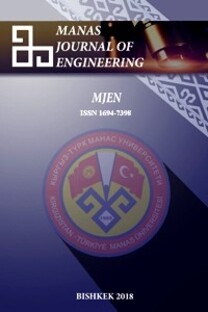Pumice and perlite co-substituted hydroxyapatite: fabrication and characterization
The purpose of this study was to combine hydroxyapatite (HA) with pumice and perlite. A precipitation procedure was applied for synthesizing pure and doped hydroxyapatite. Samples were sintered at 1100°C for 1 h. These doped structures are characterized by X-ray Diffraction (XRD), Scanning Electron Microscopy (SEM-EDS) and X-ray Fluorescence. Higher SiO2 and Al2O3 content was shown by XRF analysis. The XRD results revealed the existence of the HA, β-TCP and Ca5(PO4)2SiO4 phases. SEM images confirmed the sintering temperature and number of dopants had significant effect on grain sizes of the samples.
Keywords:
biomaterials, pumice perlite,
___
- Dorozhkin S.V., ‘Calcium orthophosphate-containing biocomposites and hybrid biomaterials for biomedical applications’, Journal of Functional Biomaterials, 6, (2015), 708–832.
- Gervaso F., Scalera F., Padmanabhan S.K., Sannino A., Licciulli A., ‘High performance hydroxyapatite scaffolds for bone tissue engineering applications’, International Journal of Applied Ceramics Technolgy, 9, (2012), 507–516.
- Ciobanu G., Ilisei S., Luca C., Carja G., Ciobanu O., ‘The effect of vitamins to hydroxyapatite growth on porous polyurethane substrate’, Progress in Organic Coating, 74, (2012), 648–653.
- Gündüz, L., Yılmaz, İ., 1998. Orta Anadolu Pomza Oluşumlarının Endüstriyel Olarak Kullanılabilirlik Ölçütleri. 4. Endüstriyel Hammaddeler Sempozyumu 118-19 Ekim 2001, İzmir, TÜRKİYE, 214-215.
- Ciobanu G., Bargan A.M., Luca C., ‘New bismuth-substituted hydroxyapatite nanoparticles for bone tissue engineering’, JOM, 67, (2015), 2534–2542.
- Tahmasebifar A., Gungor S., Evis Z., ‘The microstructural investigation of nano- calcium phosphates doped with fluoride ions’. Journal of the Faculty of Engineering and Architecture of Gazi University, 30, (2015), 1-7.
- Koc G. S., ‘Synthesis and characterization of strontium and chlorine co-doped tricalcium phosphate’. Materials Letters, 248, (2019),69-72.
- Ahn, E.S., Gleason, N.J., Nakahira, A. ve Ying, J.Y., ‘Nanostructure processing of hydroxyapatite-based bioceramics’, Nano Letters, 1, (2001), 149-153.
- Georgiou G., Knowles J.C., ‘Glass reinforced hydroxyapatite for hard tissue surgery- part 1: mechanical properties’, Biomaterials, 22, (2001), 2811-5. Bohur B.G., ‘HVOF Tekniğiyle Ti6Al4V Metal Altlık Yüzeyine Farklı Silika Kaynağı İçeren Biyoseramiklerin Kaplanması’, Yüksek Lisans Tezi, Afyon Kocatepe Üniversitesi, Fen Bilimleri Enstitüsü, (2018).
- Kılınç-Aksay, E., 2005. İzmir-Menderes Yöresi Pomza Cevherinin Kullanımına Yönelik Teknolojik Özelliklerinin Araştırılması, Dokuz Eylül Üniversitesi Fen Bilimleri Enstitüsü Doktora Tezi, 6-7.
- Li X., Yang W., Zou Q., Zou Y., ‘Investigation on microstructure, composition, and cytocompatibility of natürel pumice for potential biomedical application’, Tissue Engineering Part C, 16-3, (2010), 427-34.
- Komur B., Lohse T., Can H.M., Khalilova G., Geçimli Z.N., Aydoğdu M.O., Kalkandelen C., Stan G.E., Sahin Y.M., Sengil A.Z., Suleymanoglu M., Kuruca S.E., Oktar F.N., Salman S., Ekren N., Ficai A., Gundez O., ‘Fabrication of naturel pumice/hydroxyapatite composite for biomedical engineering’. BioMedical Engineering, (2016), 15:81.
- Samar M., Saxena S., ‘Study of chemical and physical properties of perlite and its apllications in India’, International Journal of Science Technology and Management, 5:4, (2016), 70-80.
- Yang C., Guo Y.K., Zhang M.L., ‘Thermal decomposition and mechanical properties of hydroxyapatite ceramic’. Transactions Nonferrous Metals Society China. 20, (2010), 254–8.
- Komur B. et. al. ‘Fabrication of natürel pumice/hydroxyapatite composite for biomedical engineering’ BioMedical Engineering, (2016), 15, 81.
- Mestres G., Le Van C., Ginebra M.P.,’ Silicon-stabilized α-tricalcium phosphate and its use in a calcium phosphate cement: characterization and cell response’. Acta Biomaterials, 8(3), (2012), 1169–79.
- ISSN: 1694-7398
- Yayın Aralığı: Yılda 2 Sayı
- Başlangıç: 2001
- Yayıncı: KIRGIZİSTAN-TÜRKİYE MANAS ÜNİVERSİTESİ
Sayıdaki Diğer Makaleler
Gülşen Aydın Keskin, Hande Akbaş, Tuba Öztürk
Suha Orçun Mert, Zehra Özçelik, Ceyda Kök
Tekin Şahan, Ümit Ecer, Şakir Yılmaz
Osman Gunaydın, Kadir Güçlüer, Hüseyin Boran
Janyl Iskakova, Jamila Smanalieva
Ömer Faruk Er, Adnan Aldemir, Ali Cavak, Hilal Kıvrak
On the recursive sequence $x_{n+1}=frac{x_{n-14}}{1-x_{n-2} x_{n-5} x_{n-8} x_{n-11}}$
